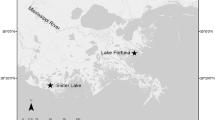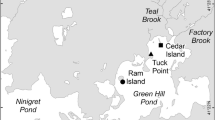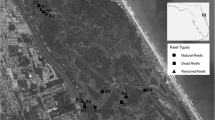Abstract
Benthic deposition of carbon (C) and nitrogen (N)-rich oyster biodeposits may increase denitrification, or anaerobic respiration of nitrate (NO3 −) to di-nitrogen gas (N2). However, environmental drivers of C and N dynamics in oyster biodeposits and reef-adjacent sediments require clarification. In July 2012, we collected intact sediment cores adjacent to and 15–20 m away from two oyster reefs (Crassostrea virginica) in Great Bay, New Hampshire, USA: one reference site and one site with cultural eutrophication. We also measured seston, chlorophyll a, and in situ oyster feeding and biodeposition. Cores were incubated in continuous-flow chambers where inflow water received 15N-ammonium (NH4 +), 15NO3 −, or no isotopes (control). We quantified fluxes of dissolved nutrients and gasses (oxygen, 28N2, 29N2, 30N2, and argon) after 24 h. Finally, we measured size-fractionated sediment organic matter. At the eutrophic site, abundant phytoplankton in the 5–28 µm size range was correlated with enhanced oyster feeding rates and biodeposit quality (lower C:N). This site had greater denitrification rates in reef-adjacent cores relative to distal cores. Low production of 29,30N2 in 15NH4 + amended cores suggested water column or biodeposit NH4 + were unlikely to be converted to N2. At both sites, reef-adjacent cores had more shell and higher 29,30N2 production with 15NO3 − addition relative to distal cores, suggesting direct denitrification enhancement near reefs. Oysters likely increased sediment N2 production via high quality biodeposits (eutrophic site), and NO3 − diffusion via structural complexity of reef-adjacent sediment (both sites). Overall, results suggest oyster-mediated ecosystems services may be expected to vary with environmental conditions.






Similar content being viewed by others
References
An S, Gardner WS, Kana T (2001) Simultaneous measurement of denitrification and nitrogen fixation using isotope pairing with membrane inlet mass spectrometry analysis. Appl Environ Microbiol 67(3):1171–1178
APHA (1998) Standard methods for the examination of water and wastewater, 20th edn. United Book Press Inc, Baltimore
Atkinson CL, Kelly JF, Vaughn CC (2014) Tracing consumer-derived nitrogen in riverine food webs. Ecosystems 17(3):485–496
Barber BJ, Langan R, Howell TL (1997) Haplosporidium nelsoni (MSX) epizootic in the Piscataqua River Estuary (Maine/New Hampshire, USA). J Parasitol 83(1):148–150
Bayne BL (2002) A physiological comparison between Pacific oysters Crassostrea gigas and Sydney Rock oysters Saccostrea glomerata: food, feeding and growth in a shared habitat. Mar Ecol Prog Ser 232:163–178
Bayne BL, Newell RC (1983) Physiological energetics of marine molluscs. In: Wilber KM, Saleuddin AS (eds) The Mollusca. Academic Press, New York, pp 407–515
Bayne BL, Hedgecock D, McGoldrick D, Rees R (1999) Feeding behaviour and metabolic efficiency contribute to growth heterosis in Pacific oysters Crassostrea gigas (Thunberg). J Exp Mar Biol Ecol 233(1):115–130
Beck MW, Brumbaugh RD, Airoldi L, Carranza A, Coen LD, Crawford C, Defeo O, Edgar GJ, Hancock B, Kay MC, Lenihan HS, Luckenbach MW, Toropova CL, Zhang G, Guo X (2011) Oyster reefs at risk and recommendations for conservation, restoration, and management. Bioscience 61(2):107–116
Beseres Pollack J, Yoskowitz D, Kim HC, Montagna PA (2013) Role and value of nitrogen regulation provided by oysters (Crassostrea virginica) in the Mission-Aransas Estuary, Texas, USA. Plos One 8(6):e65314
Bruesewitz DA, Tank JL, Bernot MJ (2008) Delineating the effects of zebra mussels (Dreissena polymorpha) on N transformation rates using laboratory mesocosms. J N Am Benthol Soc 27(2):236–251
Bruesewitz DA, Tank JL, Hamilton SK (2009) Seasonal effects of zebra mussels on littoral nitrogen transformation rates in Gull Lake, Michigan, USA. Freshwater Biol 54(7):1427–1443
Bruesewitz DA, Gardner WS, Mooney RF, Pollard L, Buskey EJ (2013) Estuarine ecosystem function response to flood and drought in a shallow, semiarid estuary: nitrogen cycling and ecosystem metabolism. Limnol Oceanogr 58(6):2293–2309
Brumbaugh RD, Coen LD (2009) Contemporary approaches for small-scale oyster restoration to address substrate versus recruitment limitation: a review and comments relevant for the Olympia oyster, Ostrea lurida (Carpenter, 1964). J Shellfish Res 28:147–161
Cerco CF, Noel MR (2007) Can oyster restoration reverse cultural eutrophication in Chesapeake Bay? Estuar Coasts 30(2):331–343
Cloern JE (2001) Our evolving conceptual model of the coastal eutrophication problem. Mar Ecol Prog Ser 210:223–253
Coen LD, Luckenbach MW, Breitburg DL (1999) The role of oyster reefs as essential fish habitat: a review of current knowledge and some new perspectives. Am Fish Soc Symp 22:438–454
Coen LD, Brumbaugh RD, Bushek D, Grizzle R, Luckenbach MW, Posey MH, Powers SP, Tolley G (2007) A broader view of ecosystem services related to oyster restoration. Mar Ecol Prog Ser 341:303–307
Cranford PJ, Evans DA, Shumway SE (2011) Bivalve filter feeding: of variability and limits the aquaculture biofilter. In: Shumway SE (ed) Shellfish aquaculture and the environment. John Wiley & Sons, West Sussex, pp 157–228
Dame R (2012) Ecology of marine bivalves: an ecosystem approach. CRC Marine Science Series, Boca Raton
Dang HY, Wang CY, Li J, Li TG, Tian F, Jin W, Ding YS, Zhang ZN (2009) Diversity and distribution of sediment nirS-encoding bacterial assemblages in response to environmental gradients in the eutrophied Jiaozhou Bay, China. Microb Ecol 58(1):161–169
Engström P, Dalsgaard T, Hulth S, Aller RC (2005) Anaerobic ammonium oxidation by nitrite (anammox): implications for N-2 production in coastal marine sediments. Geochim Cosmochim Acta 69(8):2057–2065
Eyre BD, Ferguson AJP (2005) Benthic metabolism and nitrogen cycling in a subtropical east Australian Estuary (Brunswick): temporal variability and controlling factors. Limnol Oceanogr 50(1):81–96
Eyre BD, Rysgaard S, Dalsgaard T, Christensen PB (2002) Comparison of isotope pairing and N2:Ar methods for measuring sediment denitrification—assumption, modifications, and implications. Estuaries 25(6):1077–1087
Eyre BD, Santos IR, Maher DT (2013) Seasonal, daily and diel N2 effluxes in permeable carbonate sediments. Biogeosci Disc 10:2601–2615
Fulweiler RW, Brown SM, Nixon SW, Jenkins BD (2013) Evidence and a conceptual model for the co-occurrence of nitrogen fixation and denitrification in heterotrophic marine sediments. Mar Ecol Prog Ser 482:57–68
Galimany E, Rose JM, Dixon MS, Wikfors GH (2013) Quantifying feeding behaviors of ribbed mussels, Geukensia demissa, in two urban sites (Long Island Sound, USA) with different seston conditions. Estuar Coasts 36:1265–1273
Gardner WS, McCarthy MJ (2009) Nitrogen dynamics at the sediment-water interface in shallow, sub-tropical Florida Bay: why denitrification efficiency may decrease with increased eutrophication. Biogeochemistry 95(2–3):185–198
Gardner WS, McCarthy MJ, An S, Sobolev D, Sell KS, Brock D (2006) Nitrogen fixation and dissimilatory nitrate reduction to ammonium (DNRA) support nitrogen dynamics in Texas estuaries. Limnol Oceanogr 51(1):558–568
Gobler CJ, Renaghan MJ, Buck NJ (2002) Impacts of nutrients and grazing mortality on the abundance of Aureococcus anophagefferens during and New York brown tide bloom. Limnol Oceanogr 47:129–141
Grabowski JH, Peterson CH (2007) Restoring oyster reefs to recover ecosystem services. In: Cuddington K, Byers JE, Wilson WG, Hastings A (eds) Ecosystem engineers: plants to protists. Academic Press, Amsterdam, pp 281–298
Grizzle R, Ward K (2013) Oyster bed mapping in the Great Bay Estuary, 2012-2013. Piscataqua Region Estuaries Partnership and the New Hampshire Department of Environmental Services, Concord
Grizzle RE, Brodeur MA, Abeels HA, Greene JK (2008a) Bottom habitat mapping using towed underwater videography: subtidal oyster reefs as an example application. J Coast Res 24(1):103–109
Grizzle RE, Greene JK, Coen LD (2008b) Seston removal by natural and constructed intertidal eastern oyster (Crassostrea virginica) reefs: a comparison with previous laboratory studies, and the value of in situ methods. Estuar Coasts 31(6):1208–1220
Heisterkamp IM, Schramm A, de Beer D, Stief P (2010) Nitrous oxide production associated with coastal marine invertebrates. Mar Ecol Prog Ser 415:1–9
Higgins CB, Tobias C, Piehler MF, Smyth AR, Dame RF, Stephenson K, Brown BL (2013) Effect of aquacultured oyster biodeposition on sediment N2 production in Chesapeake Bay. Mar Ecol Prog Ser 473:7–27
Hoellein TJ, Zarnoch CB (2014) Effect of eastern oysters (Crassostrea virginica) on sediment carbon and nitrogen dynamics in an urban estuary. Ecol Appl 24(2):271–286
Iglesias JIP, Urrutia MB, Navarro E, Ibarrola I (1998) Measuring feeding and absorption in suspension-feeding bivalves: an appraisal of the biodeposition method. J Exp Mar Biol Ecol 219(1–2):71–86
Jones HFE, Pilditch CA, Bruesewitz DA, Lohrer AM (2011) Sedimentary environment influences the effect of an infaunal suspension feeding bivalve on estuarine ecosystem function. Plos One 6(10):e27065
Kana TM, Weiss DL (2004) Comment on “Comparison of isotope pairing and N2:Ar methods for measuring sediment denitrification” by B. D. Eyre, S. Rysgaard, T. Dalsgaard, and P. Bondo Christensen. 2002. Estuaries 25:1077–1087 Estuaries 27(1): 173-176
Kana TM, Sullivan MB, Cornwell JC, Groszkowski KM (1998) Denitrification in estuarine sediments determined by membrane inlet mass spectrometry. Limnol Oceanogr 43(2):334–339
Kellogg LM, Cornwell JC, Owens MS, Paynter KT (2013) Denitrification and nutrient assimilation on a restored oyster reef. Mar Ecol Prog Ser 480:1–19
Koop-Jakobsen K, Giblin AE (2009) Anammox in tidal marsh sediments: The role of salinity, nitrogen loading, and marsh vegetation. Estuar Coasts 32(2):238–245
Langdon CJ, Newell RIE (1996) Digestion and nutrition in larvae and adults. In: Kennedy VS, Newell RIE, Eble AF (eds) The Eastern oyster Crassostrea virginica. Maryland Sea Grant, College Park, pp 231–269
Luckenbach MW, Mann R, Wesson J (eds) (1999) Oyster reef habitat restoration: a synopsis and synthesis of approaches. Virginia Institute of Marine Science, Gloucester Point
Malone TC (1992) Effects of water column processes on dissolved oxygen, nutrients, phytoplankton, and zooplankton. In: Smith DE, Leffler M, Mackiernan G (eds) Oxygen dynamics in the Chesapeake Bay. Maryland Sea Grant Publications, College Park, pp 61–112
McCarthy MJ, Gardner WS (2003) An application of membrane inlet mass spectrometry to measure denitrification in a recirculating mariculture system. Aquaculture 218(1–4):341–355
McCarthy M, Lavrentyev P, Yang L, Zhang L, Chen Y, Qin B, Gardner W (2007a) Nitrogen dynamics and microbial food web structure during a summer cyanobacterial bloom in a subtropical, shallow, well-mixed, eutrophic lake (Lake Taihu, China). In: Qin B, Liu Z, Havens K (eds) Eutrophication of Shallow Lakes with Special Reference to Lake Taihu, China. Developments in Hydrobiology. Springer, Netherlands, pp 195–207
McCarthy MJ, Gardner WS, Lavrentyev PJ, Moats KM, Joehem FJ, Klarer DM (2007b) Effects of hydrological flow regime on sediment-water interface and water column nitrogen dynamics in a great lakes coastal wetland (Old Woman Creek, Lake Erie). J Great Lakes Res 33(1):219–231
McCarthy M, McNeal K, Morse J, Gardner W (2008) Bottom-water hypoxia effects on sediment–water interface nitrogen transformations in a seasonally hypoxic, shallow bay (Corpus Christi Bay, TX, USA). Estuar Coasts 31(3):521–531
Murphy J, Riley JP (1962) A modified single solution method for determination of phosphate in natural waters. Anal Chim Acta 26(1):31–36
Newell RIE (2004) Ecosystem influences of natural and cultivated populations of suspension-feeding bivalve molluscs: a review. J Shellfish Res 23(1):51–61
Newell RIE, Langdon CJ (1996) Mechanisms and physiology of larval and adult feeding. In: Kennedy VS, Newell RIE, Eble AF (eds) The Eastern oyster Crassostrea virginica. Maryland Sea Grant, College Park, pp 185–229
Newell RIE, Cornwell JC, Owens MS (2002) Influence of simulated bivalve biodeposition and microphytobenthos on sediment nitrogen dynamics: a laboratory study. Limnol Oceanogr 47:1367–1379
Newell RIE, Fisher TR, Holyoke RR, Cornwell JC (2005) Influence of eastern oysters on nitrogen and phosphorus regeneration in Chesapeake Bay, USA. In: Dame R, Olenin S (eds) The comparative roles of suspension feeders in ecosystems. Nato science series IV: earth and environmental sciences. NATO science series: IV: earth and environmental sciences. Springer, Netherlands, pp 93–120
Nixon SW (1995) Coastal marine eutruophication: a definition, social causes, and future concerns. Ophelia 41:199–219
Odell J, Eberhardt A, Burdick D, Ingraham P (2006) Great Bay Estuary restoration compendium. The Nature Conservancy, New Hampshire Estuaries Project. University of New Hampshire, Dunham
Parsons TR, Maita Y, Lalli CM (1984) A manual of chemical and biological methods for seawater analysis. Pergamon Press, New York
Petersen JK, Bougrier S, Smaal AC, Garen P, Robert S, Larsen JEN, Brummelhuis E (2004) Intercalibration of mussel Mytilus edulis clearance rate measurements. Mar Ecol Prog Ser 267:187–194
Piehler MF, Smyth AR (2011) Habitat-specific distinctions in estuarine denitrification affect both ecosystem function and services. Ecosphere 2(1): art12
Piscataqua Region Estuaries Partnership (2013) State of our estuaries, 2013. University of New Hampshire, Durham
Plutchak R, Major K, Cebrian J, Foster CD, Miller MEC, Anton A, Sheehan KL, Heck KL, Powers SP (2010) Impacts of oyster reef restoration on primary productivity and nutrient dynamics in tidal creeks of the North Central Gulf of Mexico. Estuar Coasts 33(6):1355–1364
Riisgård HU (1988) Efficiency of particle retention and filtration rate in 6 species of Northeast American bivalves. Mar Ecol Prog Ser 45:217–223
Risgaard-Petersen N (2003) Coupled nitrification-denitrification in autotrophic and heterotrophic estuarine sediments: on the influence of benthic microalgae. Limnol Oceanogr 48(1):93–105
Ryther JH (1954) The ecology of phytoplankton blooms in Moriches Bay and Great South Bay, Long Island, New York. Biol Bull 106:198–209
Seitzinger S, Harrison JA, Bohlke JK, Bouwman AF, Lowrance R, Peterson B, Tobias C, Drecht GV (2006) Denitrification across landscapes and waterscapes: a synthesis. Ecol Appl 16:2064–2090
Shumway SE (1996) Natural Environmental Factors. In: Kennedy VS, Newell RIE, Eble AF (eds) The Eastern oyster, Crassostrea virginica. Maryland Sea Grant, College Park, pp 467–514
Smyth AR, Thompson SP, Siporin KN, Gardner WS, McCarthy MJ, Piehler MF (2013) Assessing nitrogen dynamics throughout an estuarine landscape. Estuar Coasts 36(1):44–55
Solorzano L (1969) Determination of ammonium in natural waters by the phenolhypochlorite method. Limnol Oceanogr 14:799–801
Thamdrup B, Dalsgaard T (2002) Production of N2 through anaerobic ammonium oxidation coupled to nitrate reduction in marine sediments. Appl Environ Microbiol 68(3):1312–1318
Wall CC, Gobler CJ, Peterson BJ, Ward EJ (2013) Contrasting growth patterns of suspension-feeding molluscs (Mercenaria mercenaria, Crassostrea virginica, Argopecten irradians, and Crepidula fornicata) across a eutrophication gradient in the Peconic Estuary, NY, USA. Estuar Coasts 36:1274–1291
Zu Ermgassen PSE, Spalding MD, Grizzle RE, Brumbaugh RD (2013) Quantifying the loss of a marine ecosystem service: filtration by the eastern oyster in US Estuaries. Estuar Coasts 36(1):36–43
Acknowledgments
Funding was provided by the Hudson River Foundation. For field assistance we thank Krystin Ward and Deb Lamson. For assistance in the lab we thank Michael Hassett, Matthew Girard, and Ashley Cook from Loyola University Chicago and Doris Law, Andrew Liang, and Erika Fusco from Baruch College. Thanks to Denise Bruesewitz for comments on an early version of this manuscript. The manuscript was also greatly improved by insightful comments from 3 anonymous reviewers and Associate Editor Leila J. Hamdan.
Author information
Authors and Affiliations
Corresponding author
Additional information
Responsible Editor: Leila J. Hamdan.
Electronic supplementary material
Below is the link to the electronic supplementary material.
Rights and permissions
About this article
Cite this article
Hoellein, T.J., Zarnoch, C.B. & Grizzle, R.E. Eastern oyster (Crassostrea virginica) filtration, biodeposition, and sediment nitrogen cycling at two oyster reefs with contrasting water quality in Great Bay Estuary (New Hampshire, USA). Biogeochemistry 122, 113–129 (2015). https://doi.org/10.1007/s10533-014-0034-7
Received:
Accepted:
Published:
Issue Date:
DOI: https://doi.org/10.1007/s10533-014-0034-7




